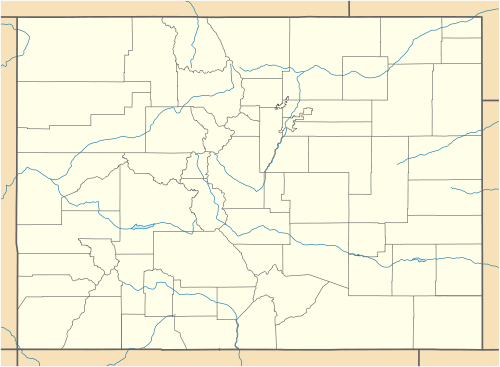Mount of the Holy Cross
| Mount of the Holy Cross | |
|---|---|
 Mount of the Holy Cross, 2009 | |
| Highest point | |
| Elevation | 14,011 ft (4270.5 m) [1] NAVD88 |
| Prominence | 2113 ft (644 m) [2] |
| Isolation | 18.41 mi (29.6 km)[2] |
| Listing | |
| Coordinates | 39°28′01″N 106°28′54″W / 39.4668287°N 106.4816869°WCoordinates: 39°28′01″N 106°28′54″W / 39.4668287°N 106.4816869°W [1] |
| Geography | |
 Mount of the Holy Cross | |
| Location | High point of Eagle County, Colorado, United States[2] |
| Parent range | Sawatch Range[2] |
| Topo map | USGS 7.5' topographic map Mount of the Holy Cross, Colorado[3] |
| Climbing | |
| First ascent | August 1873 James Gardner and W.H. Holmes[2] |
| Easiest route | North ridge: hike/scramble (YDS Class 2)[4] |
Mount of the Holy Cross is a high and prominent mountain summit in the northern Sawatch Range of the Rocky Mountains of North America. The 14,011-foot (4270.5 m) fourteener is located in the Holy Cross Wilderness of White River National Forest, 6.6 miles (10.7 km) west-southwest (bearing 244°) of the Town of Red Cliff in Eagle County, Colorado, United States. The summit of Mount of the Holy Cross is the highest point in Eagle County and the northern Sawatch Range.[1][2][3]
Mountain
Mount of the Holy Cross was named for the distinctive cross-shaped snowfield on the northeast face.[5] Under USDA Forest Service administration, the mountain was proclaimed "Holy Cross National Monument" by Herbert Hoover on May 11, 1929. The monument was transferred to the National Park Service in 1933.[6] In 1950, it was returned to the Forest Service and lost its National Monument status—the number of visitors to the mountain and the nearby "Pilgrim's Hut" had waned, and the expense of full-time staff could not be justified.
This mountain has been the subject of painters, photographers and even a poem by Henry Wadsworth Longfellow, ("The Cross of Snow"). The first publicly available photograph was published in National Geographic magazine. Thomas Moran depicted the mountain in an oil painting, which now is part of the collection of the Museum of the American West, part of the Autry National Center in Los Angeles, California.[7] It is still much photographed but it is not as well known today as it was in the past.[8]
Nearby features include Bowl of Tears Lake, directly under the east face of the peak, Tuhare Lakes, in a cirque that lies south of a significant subpeak, and several other lakes. Notable locations within 35 mi (56 km) include the Dotsero volcano (near Interstate 70), Vail and Aspen. US 24 runs near the peak through Gilman.

The first recorded ascent of Holy Cross was in 1873, by F. V. Hayden and photographer W. H. Jackson during one of Hayden's geographical surveys. However, the peak may well have been ascended previously by miners or American Indians.[9] The first winter ascent of the peak was made in 1943 by Russel Keene and Howard Freedman of the 10th Mountain Division, then stationed at Camp Hale.[9]
Holy Cross can be climbed by at least four different routes, with the easiest and most common route being the North Ridge, which involves 5,000 feet (1,500 m) of vertical gain over 11.5 mi (18.5 km) and is rated YDS Class 2 for moderate scrambling. The Cross Couloir route forms the vertical portion of the famous cross feature, and provides an advanced snow climb or extreme ski descent.[9]

Mount of the Holy Cross has a history of endangering the lives of many hikers. Primarily, the hikers who require rescue are unfamiliar with the risks of entering wilderness areas and do not bring adequate equipment and supplies to respond to emergency conditions. Although the summit on Mount of the Holy Cross is frequently reached on a long day hike, unprepared hikers are frequently stranded or lost due to changing environmental conditions and confusion regarding the surrounding landscape, especially on the descent of North Ridge. Thorough research and reasonable planning should prevent most tragedies.
Mount of the Holy cross is accessible from Tigiwon Road, south of Minturn, Colorado. The Half Moon Pass Trail is the standard route to the summit of Mount of the Holy Cross via the North Ridge. Following the Fall Creek Trail to an ascent of Notch Mountain Trail provides the best view of the Holy Cross snow feature from Notch Mountain Ridge.[10]
Historical names
- Mount Holy Cross
- Mount of the Holy Cross – 1947 [3]
See also
References
- 1 2 3 "MT HOLY CROSS ET". NGS data sheet. U.S. National Geodetic Survey. Retrieved January 8, 2016. Note: The summit of Mount of the Holy Cross is +0.61 m (+2.0 ft) higher than NGS station MT HOLY CROSS ET.
- 1 2 3 4 5 6 "Mount of the Holy Cross, Colorado". Peakbagger.com. Retrieved January 8, 2016.
- 1 2 3 "Mount of the Holy Cross". Geographic Names Information System. United States Geological Survey. Retrieved November 14, 2014.
- ↑ "Holy Cross, Mount of the". SummitPost.org.
- ↑ Gannett, Henry (1905). The Origin of Certain Place Names in the United States. Govt. Print. Off. p. 159.
- ↑ Barry Mackintosh (1995). "Former National Park System Units: An Analysis". National Park Service.
- ↑ "Thomas Moran, Mountain of the Holy Cross". National Gallery of Art. Retrieved 2011-02-21.
- ↑ Kevin Blake, 2008, Imagining Heaven and Earth at Mount of the Holy Cross, Colorado, Journal of Cultural Geography 25(1): 1-26.
- 1 2 3 Louis W. Dawson II, Dawson's Guide to Colorado's Fourteeners: Volume I, The Northern Peaks, Blue Clover Press, 1994, ISBN 0-9628867-1-8, pp. 36–44.
- ↑ Kim Fenske. Hiking Colorado: Holy Cross Wilderness. ASIN B00DE51D36.
